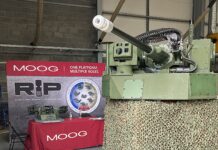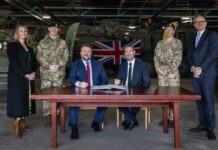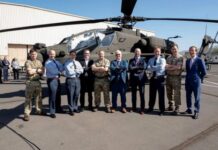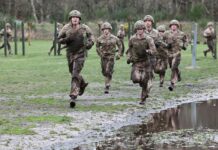The British Army is undergoing a digital transformation. Part of that change is being driven by the THEIA Programme, which marks a shift in culture and behaviour, taking the army of the industrial age into the digital age. THEIA, and digitalisation overall, will enable the army to better integrate with partners, operate in peacetime with maximum efficiency and, operationally, outcompete its adversaries.
Context
When the UK Government’s Integrated Review of Security, Defence, Development and Foreign Policy – Global Britain in a Competitive Age, was released in March 2021, it introduced Project THEIA, a comprehensive digital transformation of the British Army. While more about a shift in culture and behaviour and how the army, both in peacetime and operationally, transitions from the industrial age into the digital age, this new investment in an efficiency-focused workforce empowered to meet the digital challenges of the future, will also result in a more agile, adaptable and confident force making optimum use of latest technologies to out-compete its adversaries.
THEIA’s role in the army’s digitalisation is set to deliver essential business efficiencies to the running of the army in peacetime. Digitalisation overall will also make the army stronger in the face of current and future threats in order to wage effective, battle-winning, 21st-Century warfare. Faster, leaner and more efficient are just some of the words used by the UK MoD to describe how the resulting force undergoing this transformation will turn out.
This article looks at digitalisation of the British Army and aspects of Project THEIA, how the army is bolstering efforts to improve all aspects of its organisation’s management, whether deployed, or garrisoned, embracing new technologies and approaches along the way, which will lead to enhanced operational effectiveness.
Project THEIA – General Thoughts on Ops and Tech
Deputy Chief of the General Staff of the British Army, Lieutenant General Chris Tickell, describes Project THEIA as an ‘ambitious but critical transformation programme for the army’ taking the organisation from a relatively analogue approach to one that is digital. He has underscored and indicated that while the recent integrated review has highlighted reduced numbers in the army, a ‘re-focus’ on digitalisation and what technological capabilities are on offer will help compensate for these reduced numbers. This includes artificial intelligence (AI)-based systems and machine learning that will link man and machine in more efficient teamwork for future warfare. And while THEIA’s cultural shift will touch all business and managerial areas of running a more efficient peacetime army, operational changes to soldiering are inevitable in the coming 10 years and these latest technologies will transform some activities almost unrecognisably. That said, in the words of Lieutenant General Tickell, other fundamentals of soldiering are unlikely to change and the nature of conflict, will remain frightening, visceral and bloody ‘and nothing that technology brings to bear will take that away’.
Digitalisation’s Quantum Leap and THEIA’s Approach
Project THEIA will see massive changes in the way the army conducts and runs itself as a business and even in the peacetime context will involve AI, machine learning, and autonomy. It will also incorporate quantum computing, cyber insecurity, synthetic environments, as well as Augmented Reality (AR) and analytics. It’s important to emphasise that THEIA is not ‘doing’ digital transformation to the army, rather it is using a federated approach to cohere the digital change programmes that are being done within the business functions of the British Army, thereby giving a single common coherent framework to all the digital programmes across the army.
Operationally, digitalisation as part of other programmes, for example, will enable the force to handle the massive amounts of data that will be generated by all the latest sensors active on the battlefield. Data handled properly in the new digital domain will enable commanders to make the right decisions at the right time in order to win any engagement in which they are involved. A new digital highway is envisaged from soldier to HQ with a newly-coined adage: from bayonet to base. Not only will this enable soldiers to respond to a contact or adversarial scenario quickly, but also base that response on the best possible data and intelligence, which may only be available to them through connection with other units, friendly-force elements and upper echelons.
Cultural Digitalisation – Project THEIA’s Goals
Designed ultimately to help prepare its force for future conflict, the British Army’s peacetime and cultural digital transformation under Project THEIA, will see a digital backbone created at its core across the army’s estate that will be fundamental to the its ability to operate more efficiently in peacetime as well as conflict. Culturally, Project THEIA is about the use of digitised information and digital technologies to improve decision-making across non-operational/business functions in the army. Its objectives are to change, enhance and modernise the current digital culture and behaviours within the force, equipping individuals and units throughout the army’s estate in the UK and abroad with digital skills, promoting new and efficient digital ways of working.
Digitalisation in the Field
In the field, digitalisation objectives also encompass the integration of all information from command and control, intelligence, sensors, effectors and platforms across domains, partners and allies. This will allow manned and autonomous sensors, weapons and deciders effectively to become one ‘living’ organism, able to adapt to changing operational scenarios fast, as well as being self-healing. This self-healing capability will be a major progression for command and control elements; much like an octopus with the ability to regrow a lost tentacle, this capability gives the army the potential for any sensor that collects data to be aligned, re-aligned or re-assigned by any authorised decision-maker, whether human or an AI algorithm, to any effector, i.e. the instrument or technology that will impact a target, should any part/sensor/etc of the whole fail through technical failure or enemy action.
THEIA’s Goal-achieving Projects
In order to achieve the business and cultural digitalisation goals under Project THEIA, the army has six digital transformation projects currently underway and expected to continue through to the end of 2022, and possibly beyond. These are being supported by a specifically-established design authority, so that an agile procurement process with bespoke methodologies to help achieve results, is in place.
The first of these six projects is the Digital Estate. This is aimed at improving sustainability and efficiency across the army’s real-estate, both in the UK and overseas. Two pilot projects comprise this, the first Building an Efficiency Management System (BEMS) to manage energy efficiency and reduce carbon output at standing army garrisons and being undertaken at the army’s Catterick Garrison; the second is the creation and making best use of networked digital signage, 5G and SmartBase technology being undertaken at the army’s Larkhill Garrison. Catterick, in North Yorkshire, is currently the largest British Army garrison in the world and, covering over 2,400 acres, had a population of around 13,000 in 2017. Larkhill is the home of the Royal Artillery based on Salisbury Plain with a growing population and plans and development underway to increase the size of the garrison to eventually create the army’s largest garrison, double the size of Catterick.
Another of the digital transformation projects is the Army Estate Wide Open Internet Access project, aimed at the provision of WiFi open broadband internet access across all the army’s real-estate. This project is symbolic to THEIA and reflects increasing reliance on personal internet access for work purposes, not least for training, education and routine management. It will initially include 400 army sites with the aim to cover all 498 sites across three distinct areas: business, welfare and single-living accommodation. The intention is to further extend it to the Defence Training Estate, where it will deliver live/simulated training benefits.
The next project in the group of six is Equipment Information Exploitation to enable accurate planning and monitoring of army fleet maintenance and sustainment. For example, the Babcock-delivered Armoured Fighting Vehicle condition-monitoring trial is currently aiming to achieve a 10 per cent potential savings from the £100-million projected running costs of this AFV programme.
The Army Career Management Tool has been built by the digital team as part of the next project of the six, Digital Army Personnel Processes. This sees the automation of manual, paper-based processes into a suite of digitally-integrated workflows for the purpose of conducting promotion and selection boards. Some 291 promotion boards have been conducted since mid-2020 using the tool, providing more time for career managers to focus on individual needs of recruits, whether soldiers or officers. In a similar vein is the Foundation of Digital Skills project, which sets out to upskill the workforce with the skills necessary to adapt to the fast-paced advances in technology and be leaders in the digital age. Focus in the short term is on analysing and mapping the training need to deliver high-quality, relevant individual and collective digital skills from foundation to specialist.
Last but not least of the six projects setting out to achieve the aims of Project THEIA is Digitalising the Field Army, where the project’s Field Army Information Exploitation Team is gathering together previously-generated data from various operational and other sources to provide a dynamic understanding of the army’s readiness, deployability and availability for land operations.
Reserve Knowledge for THEIA
In addition to the projects outlined, other moves are underway to lead this digital transformation. At the end of April 2021, for example, it was announced that 30 army reservists, with civilian jobs in the digital and technology industries, had joined the THEIA programme, bringing their commercial experiences and skills to bear on helping innovate and develop the army’s own digital skills. Reservist Brigadier Marc Overton was one those who took part. In his civilian career he is the Chief Solutions Officer for global the Internet of Things (IoT) leader, Sierra Wireless. He said at the time, “As an army we need to focus on developing our technological and information advantage against our adversaries. To do that we need to ensure that we have the right people with the right skills and access to the right technology in the right places. The army is just like any other large complex organisation going through a digital transformation. It has legacy systems, process and behaviours that need changing. In my experience the technology is the easy part, behaviours, skills and culture often take longer to change, the army is no different in this. Ultimately, we need to be much faster at delivering the right data to those who need it. The key is to accelerate the information decision-making cycle. At the same time to run the business we need to use digital solutions to be the most efficient organisation we can be.” Fellow reservist working on THEIA in the same drive was Lieutenant Colonel Chris Sykes. In civilian life he’s the Head of Digital Transformation for a consultancy specialising in support to the public sector. “Project THEIA is the programme wrapper around the army’s digital transformation,” Sykes said. “As an army we need to maintain a technological edge against our competitors. Ultimately, we need to be much faster at delivering the latest technology to those who need it; and that we have individuals who not only know how to maximise its use but can experiment with it to push the limits even further.”
Closing Remarks: Programme Manager THEIA
Following release of the Integrated Review last year, Brigadier Stefan Crossfield, Programme Manager THEIA, said that conflict in the digital age will require a digital army that can relentlessly out-compete its adversaries, seamlessly integrate with partners and enable its people, equipment and resources to operate with maximum efficiency. It will be underpinned by a digital backbone that delivers hyper-connectivity to leverage high-quality, secure, extensive data and will be operated by a digitally-talented workforce. “THEIA is not just about exciting bits of technology being able to speak and work with each other – although that is a considerable task that we are on. It’s about integrating the army’s ways of working, training, language, structure, culture internally and externally with allies and partners. It’s a mammoth task, but one that, as a central pillar, will enable the implementation of a truly ‘Integrated Review’ to deliver a digital army.”






![Are you deceiving me? A dummy Sherman tank, of the type used by FUSAG. [US National Archives]](https://euro-sd.com/wp-content/uploads/2025/05/Dummy-Sherman-tank_US-National-Archives-Kopie-218x150.jpg)




